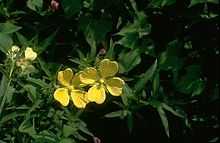Ludwigia decurrens
From Wikipedia, the free encyclopedia
| Ludwigia decurrens | |
|---|---|
 | |
| Conservation status | |
| Scientific classification | |
| Kingdom: | Plantae |
| (unranked): | Angiosperms |
| (unranked): | Eudicots |
| (unranked): | Rosids |
| Order: | Myrtales |
| Family: | Onagraceae |
| Genus: | Ludwigia |
| Species: | L. decurrens |
| Binomial name | |
| Ludwigia decurrens Walter | |
Ludwigia decurrens is a species of flowering plant in the evening primrose family known by the common names willow primrose and wingleaf primrose-willow. It is native to the central and eastern United States.[1]
This species is an annual or woody perennial herb growing up to 6 feet tall. It has an erect form and a winged stem. The linear leaves are alternately arranged. The flower has four to five yellow petals.[2]
This plant grows in wet habitat types, often alongside Polygonum and Cyperus species.[2]
This species has been shown to have allelopathic effects on other plants.[3]
| Wikimedia Commons has media related to Ludwigia decurrens. |
References
- ↑ Ludwigia decurrens. NatureServe.
- ↑ 2.0 2.1 Ludwigia decurrens. USDA NRCS Plant Guide.
- ↑ Sakpere, A. M., et al. (2010). Allelopathic effects of Ludwigia decurrens and L. adscendens subsp. diffusa on germination, seedling growth and yield of Corchorus olitorious L. Not Sci Biol 2(2) 75-80.
External links
This article is issued from Wikipedia. The text is available under the Creative Commons Attribution/Share Alike; additional terms may apply for the media files.
